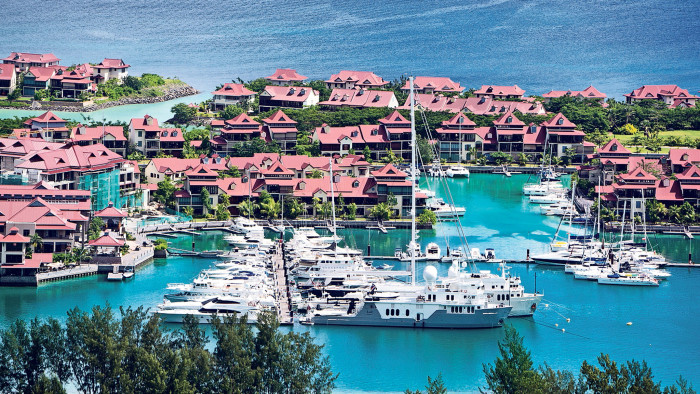Providers of superyacht services vie to exceed expectations

Roula Khalaf, Editor of the FT, selects her favourite stories in this weekly newsletter.
As the size of superyachts has increased over the past decade, so too have the expectations of their owners and users about the service they receive, both on board and ashore.
In response, marinas that cater for the largest yachts have stepped up their facilities, and now offer concierges and business centres, while also managing more closely the environmental impact of their operations.
One of the newest superyacht marinas in the Caribbean is to be found on the island of St Kitts at Christophe Harbour — a private island community that will soon have a Park Hyatt hotel and Tom Fazio golf course.
Alongside the YU Lounge (an exclusive terminal for private jet charter on the island), Christophe Harbour now offers a convenient way of easing the transition from air to water.
Over at OneOcean Port Vell in Barcelona, Martin Bellamy, chief executive of Salamanca Group, which developed and operates the port, says the pressure is on in the Mediterranean to improve all aspects of yacht ownership. His company has invested $100m over the past five years.
Aside from having dedicated space for yachts up to 190 metres in length, the marina includes a private members’ club, restaurant, cocktail bar, a 24-hour concierge, a gymnasium, wellness centre, business hub and crew lounge, in an eye-catching, high-spec design.
It is a move to enrich the marina experience in a highly competitive market, where a 21-year lease for a 180m yacht sells for a negotiable €6,000 per sq metre (length x beam) — and typically increases in value.
The number of superyacht marinas with the capacity to accommodate at least a 50m vessel has now reached 412 around the world, according to Superyacht Intelligence, the industry analyst.
Just under half of these are in Europe, with a further 9 per cent in Florida and the Caribbean, and 9 per cent in the Pacific.
A growing trend among yacht users is cruising to remote areas where few such luxury facilities were available in the past. But the desire to capitalise on traffic has driven investment in locations far from the well-travelled routes of the Riviera or Leeward Islands.
In the Seychelles, for instance, Eden Island marina has evolved to service yacht owners and charterers. In operation since 2007, the marina recently expanded its facilities so that it can cater for all sizes of vessel.
Mike King-Harman, chief executive of Hunt, Deltel & Co, which developed and manages the marina, says: “Of the current list of the 100 largest superyachts, 26 have visited the Seychelles.”
But that traffic does bring potential problems — owners, captains and guests may expect more elaborate services in keeping with the supersize boats.
“We occasionally get suggestions about providing more facilities,” says Mr King-Harman. “But our view is that if you want St Tropez, then go there. Seychelles has a unique and unspoilt environment to offer.”
The issue of local impact is growing in importance. Marinas have to ensure that they adhere to stricter marine pollution regulations. Several have submitted to the sustainable development standard ISO 14001, and have pledged to ensure that owners and guests also help to protect the environment where they are holidaying.
Marinas are expected to perform better on a number of levels — without losing sight of the basic services that all boats inevitably need.
Marina construction, for instance, has an environmental impact, but examples such as Port Adriano on Mallorca, which became operational three years ago, try to address green issues throughout.
Along with using a 100 per cent renewable energy supplier, the port was designed to use the sea to reduce reliance on electricity.
“Port Adriano is the only superyacht marina that has implemented an air conditioning system using 19-degree seawater as a source of energy,” says Antonio Zaforteza, head of Ocibar, which developed and operates the port.
“It cools in the summer and warms in the winter, and results in a reduction of 30 per cent in electricity consumption and thus in an important reduction of CO2 emissions.”
Comments